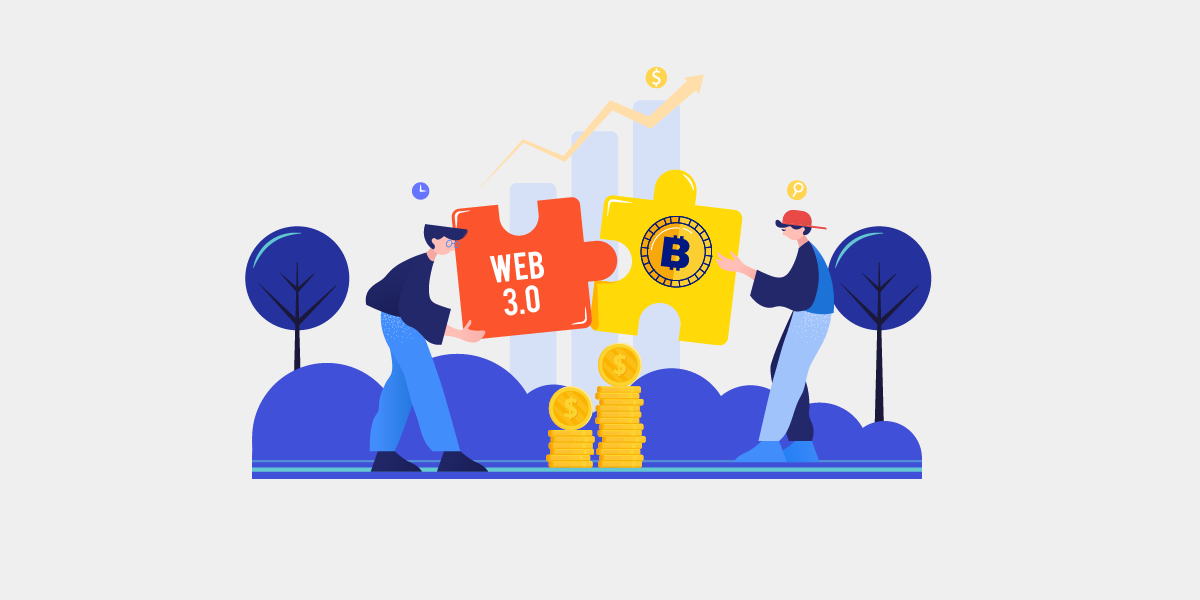How Blockchain’s Web 3.0 Would Impact Businesses
Ever since the arrival of the first Web version back in the 90s by Tim Berners-Lee in Switzerland, the modus operandi has undergone significant changes, especially in terms of interactivity and data usage.
From once being a readable model to now – its current standing of being both readable and writable – www has gone through several changes.
It is now time to enter the third phase of www evolution – the phase where the true power lies in the hand of the users. Web 3.0 Blockchain is the true revolution that, after placing itself as a major Blockchain technology trend, has started unfolding itself in the corners of the world wide web.
Driven by the most disruptive technology of our time, Web 3.0 is getting prepared to change how businesses operate and how internet users interact with the digital world. In this article, we are going to look into Web 3.0 Blockchain in detail – what it is, what it entails, the benefits it poses, and the industries it would revolutionize and how can a company use web 3.0 technologies to gain a competitive advantage?
Table of Content:
- History of Web: Web Evolution from 1.0 to 3.0
- Inception of Web 3.0
- What is Web 3.0
- Web 3.0 Blockchain Stack
- Real-Life Examples of Web 3.0 Dapps
- Why does Web 3.0 Matter to Your Business?
- Components of Web 3.0
- Advantages of Web 3.0
- Web 3.0 – Across Industries
- FAQs About Web 3.0 Blockchain
- Conclusion
There’s plenty of whispers around Web 3.0 and the revolutionary changes it will bring to the entire digital world. But even amidst the buzz very few people know what led to this web version, what is the history of Web 3.0, and what changes it would bring in.
In order to understand Web 3.0 to its entirety it is important to look back at its predecessors – Web 1.0 and Web 2.0.
History of Web: Web Evolution from 1.0 to 3.0
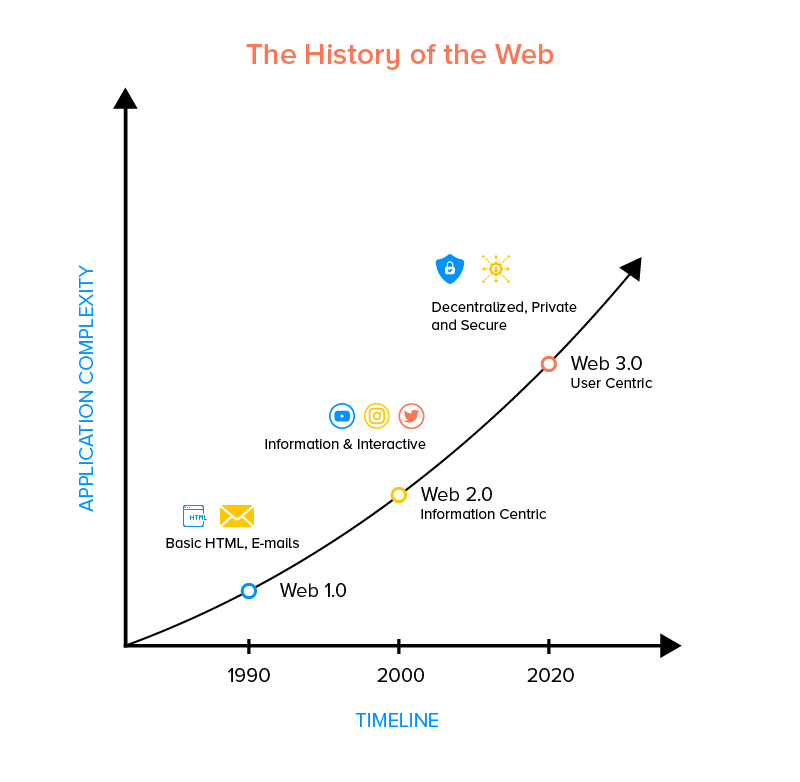
Web 1.0
It was the “readable” phase of the World Wide Web domain cluttered with flat data. In the Web 1.0, there is very limited interaction happening between web users and websites. Web 1.0 at its base was an information portal which gave users passive information without giving them a voice.
Web 2.0
Web 2.0 changed everything that Web 1.0 stood for. It opened avenues for users to interact with businesses. Denoted as the “writable” phase of the World Wide Web it allowed users to interact freely with each other, encouraging high participation, greater collaboration, and real-time information sharing.
Web 2.0 came with the age of social media which made the otherwise observant web interactive. Brands and consumers got a voice that they were using to put across their opinions in the world. The age of complete visibility and exposure had finally come.
Web 2.0 was a dream come true for the voiceless and those who wanted to reach the world. All until….
The UN found out that the number of internet users had increased from its 738 million count to 3.2 billion between 2000–2015. And they were bringing with themselves massive amounts of data.
And as soon as the big corporations realized that the unfathomable amount of personal data that was now available on their fingertips was the most expensive asset, stockpiling of data began in the centralized servers of Amazon, Facebook, and Google.
Internet users started sacrificing their security for the convenience of better services and before they knew, their browsing habits, identities, and online shopping was sold to the highest bidder with questionable motives.
Inception of Web 3.0
This concentration of data in the hands of tech behemoths who had money and connection soon started showing its evil side. News of popular brands selling and being careless about our data started emerging.
With the instances slowly leading to financial loss and identity theft, the users started looking away from convenience and started questioning the worth of a quality that was leaving them exposed.
The time was to bring back the power of data to end users. Decentralization is what was needed, Blockchain was the means, and Web 3.0 was the aim.
What is Web 3.0?
The answer to what Web 3.0 technology is- it is a fair and transparent network where people will interact without the fear of loss of security or privacy. The web version will make the internet intelligent, by bringing together the power of Artificial Intelligence and Big Data – all the while making web semantic.
Web 3.0 is the time when the web will be powered by Blockchain to become more human.
Blockchain will drive the process of how data is collected and managed across the web. The technology will bring together all the concentrated data with the help of AI and IoT and convert it into information that cannot be hacked or duplicated.
Web 3.0 Blockchain Stack
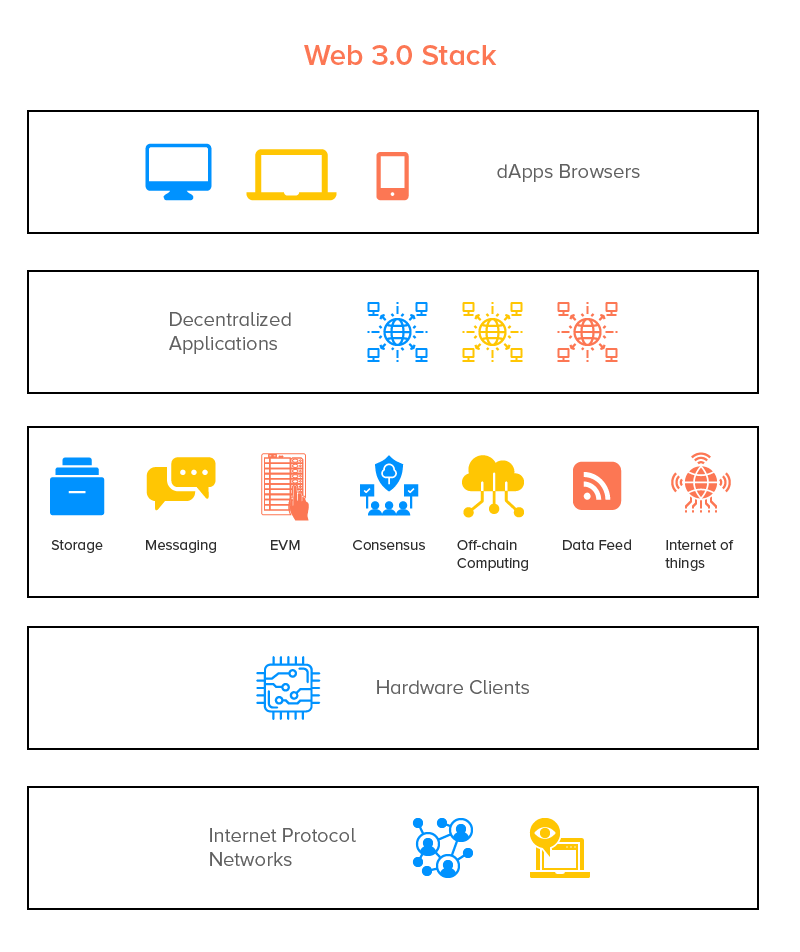
The transition from Web 2.0 to Web 3.0, while we have minimal to zero impact on the end users, will bring a revolutionary change in the backend. For a client-server model to become open and decentralized, the core tech stack of the web will have to change.
While the actual Web3 Technology Stack is not out yet, this is what we assume the Web 3.0 blockchain technology stack would look like –
While usually, an app is kept on the top layer in the tech stack, it is not the same in case of decentralization driven solution, for blockchain elements are mainly back-end focused. This is the reason why there are more elements on top of the app level as an answer to how will Web 3.0 IT stack function?
The development of semantic technologies can enhance the Web3.0 use. To make it the data protection tool, it is essential to base this technology on blockchain logic. As the real blockchain logic will make sure that we carry our data in a local manner. The peer to peer review system will keep users alert of the data block building.
Real-Life Examples of Web 3.0 Dapps
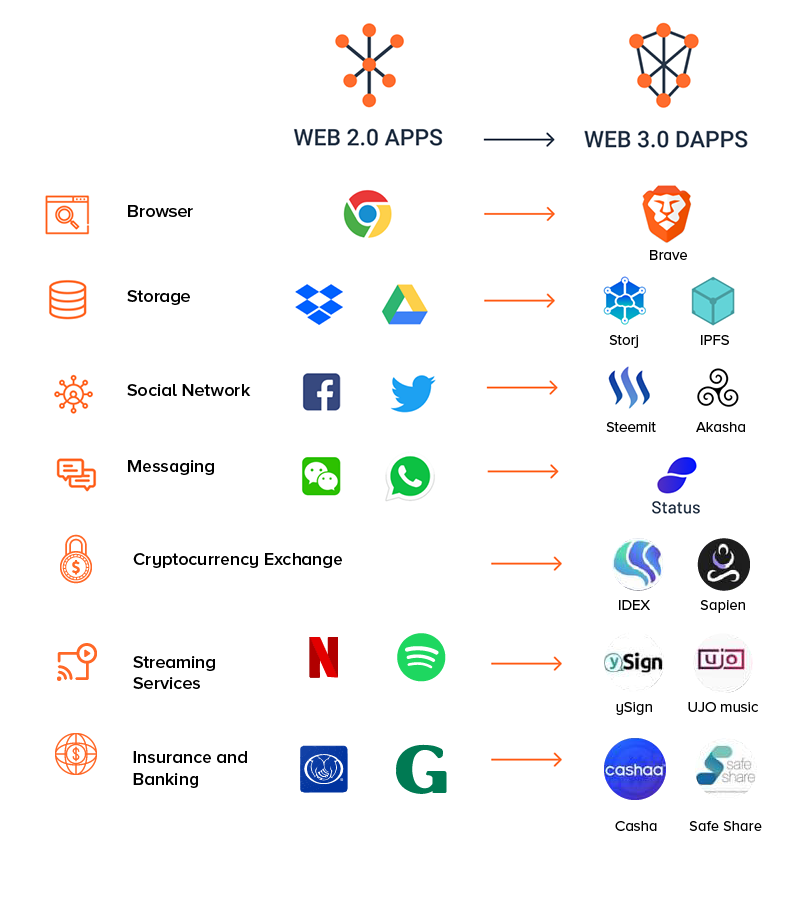
The Dapp driven web version presents a number of alternatives that users can interact with instead of the centralized data driven traditional business models. Even now, when Web 3.0 has not even reared into action, there are platforms and apps developed by future centric blockchain development company, which are posing as the decentralized, user centric alternative to the centralized platforms backed by monopolizing tech behemoths.
Why Does Web 3.0 Matter to Your Business?
The effect of web 3.0 on business will be inclined at making them transparent and highly user centric. Everything that was wrong with how businesses were operated in terms of users’ data will see a revolutionary change.
To answer how will businesses use web 3.0 technologies?, businesses – both traditional and new, will open the gates for Blockchain and the capabilities the technology brings alongside. You will see your apps getting a Blockchain upgrade, where everything will be made transparent and open to access for all.
Components of Web 3.0
In order to achieve everything that is expected out of Web 3.0 Blockchain, many technologies will have to unite and come on the forefront, meaning the integration of blockchain technology will not be enough. In order to make the web decentralized and semantic, the emerging technologies of our time will become the main components of the Web 3.0.
- With Augmented and Virtual reality and high-fidelity 3D graphics, the user interface of digital web will combine with the physical, real world. The gap between the digital and physical environment will fill and we will expand the capability to bring physical objects in the digital world and digital objects in the physical world.
- With IoT devices running on ever-increasingly advanced networks such as 5G, the Web will be ubiquitous through internet connected computer interfaces of physical objects. Everything from phones to watches, cars to drones, and refrigerators to ovens will be connected to the internet.
- With artificial intelligence technology, computers will analyze and learn on the move to offer user-centric interactions. Capabilities like chatbots acting on the front end, combined and machine learning algorithms working on the back end will make user experience relevant and semantic by analyzing structured and unstructured data sets.
Advantages of Web 3.0
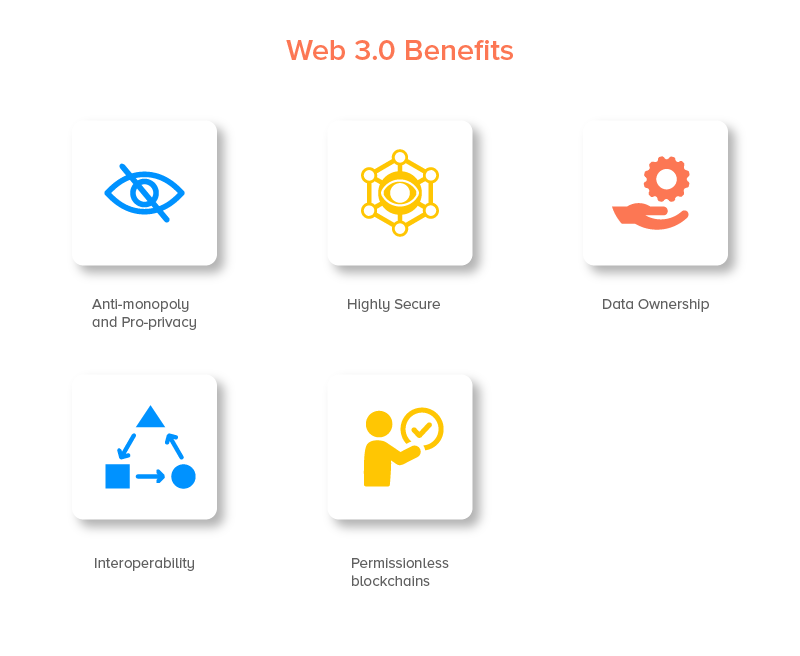
Pro-Privacy and Anti-Monopoly
Web 3.0 features will bring pro-privacy and anti-monopoly models on the table. It won’t incentivize centralized platforms who keep the control of users’ data in their hands. We will see a turnaround with decentralization and privacy coming at the center. With users now controlling how their data is viewed, the monopoly of tech giants will end and there will be less to zero instances of data privacy hacks.
Highly Secure
The Web 3.0 will be a lot more safe than its predecessors. Powered by decentralization and distributed nature, it will become impossible for hackers to penetrate the network without the operation being traced back to them.
Data Ownership
Up until now, the data generated by users were managed and used by tech behemoths. With Blockchain powered Web 3.0, the end users will get complete data ownership. Data which is transferred through the network will be totally encrypted. Users will be able to decide the information they want to share with corporations and advertising firms and will be given the opportunity to earn from it.
Interoperability
Web 3.0 features would allow users to access data across multiple applications without needing to be on any specific platform. This means, you will not have to worry about a single device being accessible to Web 3.0 while not others.
Permissionless Blockchain
Web 3.0 blockchain will not need a central authority. Anyone will be able to join the network and participate in it by creating an address. This will eliminate the occurrence of users getting barred on the basis of their gender, income, orientation, geographical or other sociological factors. It will also make it possible for digital assets and wealth to be transferred cross-border in a time and cost efficient manner.
Web 3.0 – Across Industries
1. Social Media
Social networks are a very crucial part of our lives. It holds the power to transform how we communicate, interact with each other and form communities. The platforms are censored and limiting, while working with one agenda or the other.
Web 3.0 completely changes the equation and how an app development company makes social media applications. It takes the control of data from the platforms and brings it back to the end users – meaning, spinning of story becomes impossible while it becomes impossible to misuse data, like what happened in the case of Facebook Cambridge Analytics Scandal.
Benefits of Web 3.0 Social Media
- No centralized authority to capture data and use it
- Empowers the users by rewarding them assets
- Protect the privacy of the users
- Impersonation becomes impossible
2. Currency Exchange Service
When it comes to currency exchange, centralization doesn’t work. An example of failure can be seen in the case of Mt Gox hack, where $460 million worth of bitcoins were hacked. The solution to exchanges becoming hackers’ breeding ground is decentralized exchange. Web 3.0 will see decentralized exchange gaining popularity for providing seamless user trade experience without thinking of issues related to hacks or lack of transparency.
Benefits of Web 3.0 Currency Exchange
- Cost and time efficient transactions
- Difficult to hack
- Works perfectly with the hardware wallets
- Users having full control on their funds
3. Messaging Platforms
Messaging has always been a prominent part of our lives. While on the personal front, we have been revolving around Facebook Messenger and WhatsApp since as far as we can remember, on the work front, apps like Slack and Telegram take their place.
While there are less negative reports about the current messaging platforms, there are two issues that messaging app users continue to suffer from – unsafe transmission of messages and reliance on centralized solutions which makes the platforms open to hacks.
The solution to these issues are Web 3.0 driven messaging apps like ySign, Obsidian, e-Chat, etc. who runs by the power of Blockchain to maintain users’ privacy and security.
Benefits of Web 3.0 Driven Messaging Apps
- Utmost privacy
- Inability to use data for advertising
- Sending assets in a secure and fast way
- Fast transactions
4. Data Storage
As a normal user, we store our data in Google Drive or iCloud. For companies, however, the need and situation is entirely different for they need a much robust and highly scalable centralized solution for storing their data.
Majority of the data storage operatives in the market today are centralized, meaning the data can be manipulated or sold for advertisements. Something that brands like Uber, LinkedIn, and T-Mobile have already fallen prey to.
The solution to this is the decentralized storage facility that Web 3.0 comes with. The idea behind it is that the files and data are first encrypted and then shared through a peer to peer network, meaning they are not stored in any one place but on multiple nodes.
Benefits of Web 3.0 Data Storage
- Works well across blockchain solutions and platforms
- Protects data being transferred through strong encryption
- Absence of a centralized entity
- Works seamlessly with next gen technologies like IoT
5. Streaming Service
Streaming is hands-down one of the most flourishing industries of our time. The industry is known to make brands like Netflix and Spotify the entertainment industry’s leaders.
But even after being one of the most profitable sectors, streaming services don’t come free of accusations that the data is being used for advertisement purposes and that the creators are not being paid their fair share.
Blockchain, through its decentralization and smart contract functionalities solve these pestering issues for Web 3.0.
Benefits of Web 3.0 Streaming Services
- Content creators can work transparently
- Zero copyright issues because of smart contracts
- Lack of absurd policy for content creators and streamers.
6. Insurance
Since a very long time, both the insurance and banking sectors have witnessed backlash for being money-making entities. An image that they have been changing by utilizing the decentralized and transparent nature of Blockchain.
The technology is poised to make filing insurance claims and eliminating false claims a reality of Web 3.0. It will also open the world to the reality of Open Banking, something that has been seen as a distant dream since forever.
Benefits of Web 3.0 Insurance
- Fewer to zero frauds
- Improved customer experience
- Hassle-free cross border payments
- Transparent internal audits of banks.
7. Browser
Google Chrome and Mozilla Firefox are the two tech behemoths that presently rule Web 2.0. But for a web to be as philosophical as Web 3.0, the need is to have a decentralized web. These next gen web browsers should be able to hold users data without leaking it or using it to grow their business.
Web 3.0 browsers should protect users’ data through encryption while giving them the option to get paid in turn of giving out their personal information.
Benefits of Web 3.0 Browsers
- Users can privately browse internet
- Very few security loophole
- Users can get paid in return of selling their data
- Secure and fast
FAQs About Web 3.0 Blockchain
Q. What is Decentralized Web App?
Decentralized web app (or Web 3.0 Blockchain app) are the dApps which would make the web open and transparent. Powered by blockchain technology, these apps will end the monopoly of the tech behemoths and bring the power of data back to the end users.
Q. How Web 3.0 Will Create New Business Models?
Web 3.0 is majorly driven by Blockchain technology, which in itself operates with a revolutionary new model – decentralization. The moment Web 3.0 comes into full force, the companies relying on users’ data to operate will cease to exist and the ones which have been operating in the background will come to the forefront. Businesses will also have to look into new ways to conduct their business in an era where everything from banking to data will be open and transparent.
We feel that small businesses will be the most to gain in the whole Web 3.0 scenario, especially because the monopoly of the tech behemoths will end and the established brands will undergo a major overhaul to survive the change.
Q. What is Semantic Web Technology?
Semantic Technology denotes defining and linking of data on the web by the creation of languages used for expressing rich, self-describing correlations of data in the form that only machines can process. This technology, when incorporated in the Web structure will lead to the creation of a web where machines understand humans almost seamlessly. Every interaction that happens between humans and the web will be in line with what the users were looking for/ thinking of.
Future of Web 3.0
Web 3.0 will redefine how we interact with the digital world and the change will not just be for individuals. The effect of Web 3.0 on businesses – both traditional and disruptive will be equally massive.
The transition from Web 2.0 to Web 3.0 however, will not happen overnight. Meaning, businesses will have time to look back at their process and see where they fit in the decentralization and transparency radar. But even though Web 3.0 is in the future, the reality of today is that businesses need to start preparing. Let our Blockchain experts help you.

strategies your digital product..
